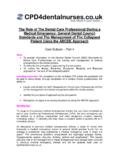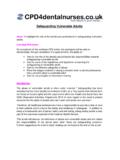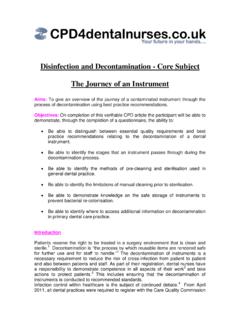Transcription of Enhanced Continuing Professional ... - CPD 4 …
1 Enhanced Continuing Professional development and Personal development Planning Aims: To make participants aware of the current General Dental Council (GDC). Continuing Professional development (CPD) requirements and to be aware of the planned Enhanced CPD requirements. Learners will also be introduced to Personal development Planning (PDP) and reflective learning. Learning Outcomes: On completion of this verifiable CPD article the participant will be able to demonstrate, through completion of a questionnaire, the ability to: Understand the General Dental Council's new Enhanced CPD requirements;. Understand the importance of CPD;. Identify the General Dental Council's Higher Level Learning Outcomes;. Understand the importance of personal development planning to ensure that CPD is matched to the needs of the individual to improve Professional practice;. Identify learning needs and apply this to personal development planning; and, Understand the importance of reflection on CPD activities.
2 Introduction All dental professionals have a duty to ensure that they are keeping their skills and knowledge updated. Undertaking CPD is a requirement of registration, is an important part of maintaining the GDC standards, and makes an important contribution to patient safety. Dental professionals need to ensure that they work within their scope of practice and provide the best quality care possible and therefore make an effective contribution to CPD for dentists and Dental Care Professionals (DCPs) is defined as study, training, courses, seminars, reading and other activities undertaken by a dentist or dental Professional , which could reasonably be expected to advance their Professional development , as a dentist or dental Professional 1. Changes to the current CPD requirements will come into force for Dentists in January 2018, and for DCPs in August 2018. This article will discuss the new Enhanced CPD. requirements and will provide information on how to prepare a PDP and practice reflective learning, both of which will be requirements of the new CPD scheme.
3 Current CPD Requirements Principle 7 of the GDC Standards for Dental Professionals state that You must update and develop your Professional knowledge and skills throughout your working life.. Specifically, the standards state: You must make sure that you know how much Continuing Professional development activity is required for you to maintain your registration and that you carry it out within the required time.. You should take part in activities that maintain update or develop your knowledge and skills. Your Continuing Professional development activity should improve your practice. 2. Dental nurses are currently required to complete 100 hours of non-verifiable CPD and 50 hours of verifiable CPD in every 5 year cycle. At the end of the five year cycle, the GDC will carry out a CPD audit. As part of this audit you may be contacted and be asked to provide documentary evidence of your participation in CPD activities and documentary evidence that your verifiable CPD has fulfilled the verifiable Many of our members have already been successfully audited.
4 Records should be kept for five years after the end of your CPD cycle. Highly Recommended CPD. The GDC have identified some subject areas that dental nurses are highly recommended to do as part of the minimum verifiable CPD requirement. These subjects are recommended as they contribute to patient safety. Currently, these subjects are: Medical Emergencies- At least 10 hours in each 5 CPD cycle (recommended 2. hours per year). Disinfection and Decontamination- At least 5 hours in each CPD cycle. Radiography and radiation protection- At least 5 hours in every CPD cycle. Currently, additional non-verifiable or verifiable CPD is also recommended by the GDC. in the following areas: Legal and ethical issues Complaints handling Oral Cancer: Early detection Safeguarding children and young people Safeguarding vulnerable adults There are no compulsory subjects that need to be completed. Registrants are expected to use their own Professional judgement when planning and undertaking CPD, ensuring that it is relevant to their individual field and scope of practice.
5 New Enhanced CPD. In the summer of 2011, the GDC launched a review of CPD. The review process included a range of information gathering, research and consultation. The GDC. consultation on CPD held from October 2012 to January 2013, indicated strong support for the new CPD proposals that aims to enhance the current requirements. Key policy factors in developing the new CPD rules have been to optimise the quality and impact of CPD on dental practice; the contribution that the GDC's CPD. requirements can make to Continuing assurance of practice; and as an important precursor to a scheme of revalidation. 4. The work of the GDC is defined and governed by the Dentists Act 1984, which sets statutory objectives to protect patients and to promote public confidence. As such, the GDC: sets standards for education and ensures trainees are taught the right skills;. maintains a register of dentists and dental care professionals, checking that people meet the requirements to be on the register.
6 Sets and promotes Professional standards and ensures that skills and knowledge are kept up to date through CPD. investigates allegations of impaired fitness to practise'. The first three of these functions, namely education, registration and setting standards, are all considered to be preventative or upstream' measures. The aim is to reduce the risk of delivering compromised patient care standards that may lead to harm or risk of harm and therefore to a case of fitness to practise. The aim of the new Enhanced CPD. requirements is to shift the balance to focus on the upstream' approach, in order to reduce the likeness of harm occurring in the first place by ensuring that CPD, Professional standards and good practice is embedded into each professionals' life and that they are completing CPD that is relevant to their individual scope of practice and learning needs. The aim is to focus the dental Professional on providing high quality patient care and maintain Professional Key Changes to CPD Requirements Dental nurses will still be required to complete 50 hours of verifiable CPD over a five year cycle.
7 The key changes are: 1) removal of non-verifiable CPD;. 2) inclusion of provisions requiring CPD to be more evenly spread throughout the cycle; and, 3) the emphasis on reflective practice, and the use of the Personal development Plan (PDP) to identify learning needs and direct 1) Removal of non-verifiable CPD. The new Enhanced CPD scheme is planned to be launched on 1 st August 2018 for DCPs. From this date, non-verifiable CPD will no longer be required. This means that only verifiable CPD is admissible under the new scheme. For dental nurses who end their current CPD cycle in July 2018, only 50 hours of verifiable CPD will be required for the following CPD cycle. If dental nurses are midway through a CPD cycle in August 2018, a pro-rata approach will be applied, taking into account the requirements of both schemes. This means that some non-verifiable CPD may be required. There is a transition tool that can be used to help work out how many hours of non-verifiable CPD will be required for dental nurses who are mid-cycle, and this is available from the non-verifiable CPD section of the website.
8 2) Spreading CPD more evenly throughout the cycle A CPD statement must be made in each year, even if zero hours are declared. Under the Enhanced CPD scheme, you must declare at least 10 hours in every two years. This means that you must still complete 10 hours in each two year period, even if you have already met the minimum required number of verifiable CPD hours of the 5 year cycle. At CPD4dentalnurses, we add verifiable CPD articles at regular periods during the year, so if you complete each article as it is released, you will meet these requirements. 3) Emphasis on reflective practice and Personal development Planning Registrants will be required to produce a PDP and demonstrate reflective learning. The following steps are detailed in the new GDC Enhanced CPD scheme 6 and will be explained in more detail: 1) Plan: Learning needs will be identified through the use of a PDP. 2) Do: Once learning needs have been identified, CPD should then be planned and completed accordingly.
9 3) Reflect: Once the CPD activity has been completed, it can then be reflected upon. 4) Record: Correct documentation needs to be kept. The following section will assist you in producing your PDP. This section will be updated as necessary once the new Enhanced CPD scheme starts. Guidance on how to complete a PDP. What is a PDP? A PDP can be defined as a process by which we identify our educational needs, set yourself some objectives in relation to these, undertake our educational activities and produce evidence that you have learned something useful. Therefore, constructing a PDP, follows the GDC approach to plan, do and reflect. By identifying learning needs, participating in a related CPD activity, and improving Professional standards, the aim is to feel in control of your own learning and future career. The PDP will ensure that the learning needs are matched to the dental Professional 's requirements and field of practice, thus ensuring that the CPD completed will have an impact improving Professional practice.
10 Step one Identify Learning Needs (plan). The GDC advise that learning needs can be identified individually or in conjunction with peers and colleagues. Learning needs may also be identified through patient feedback, a significant event or at a staff In the new Enhanced CPD programme, the GDC has four learning development outcomes that CPD must be mapped against for each activity completed. Each piece of CPD you complete should link to at least one development outcome (A,B,C or D). The development outcomes are as follows: development Outcome6 Example of CPD content6. A. Effective communication with patients, the Communication skills dental team, and others across dentistry, Consent including when obtaining consent, dealing Complaints handling with complaints, and raising concerns Raising concerns when patients are at risk; Safeguarding B. Effective management of self, and Effective practice management effective management of others or Business management effective work with others in the dental Team working team, in the interests of patients at all times; providing constructive leadership where appropriate.


